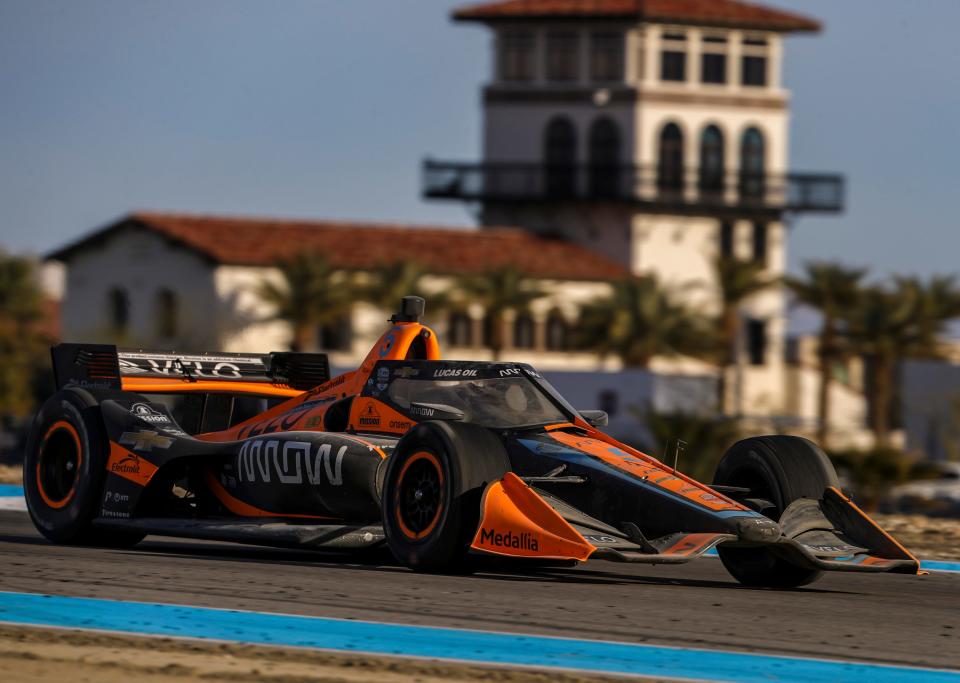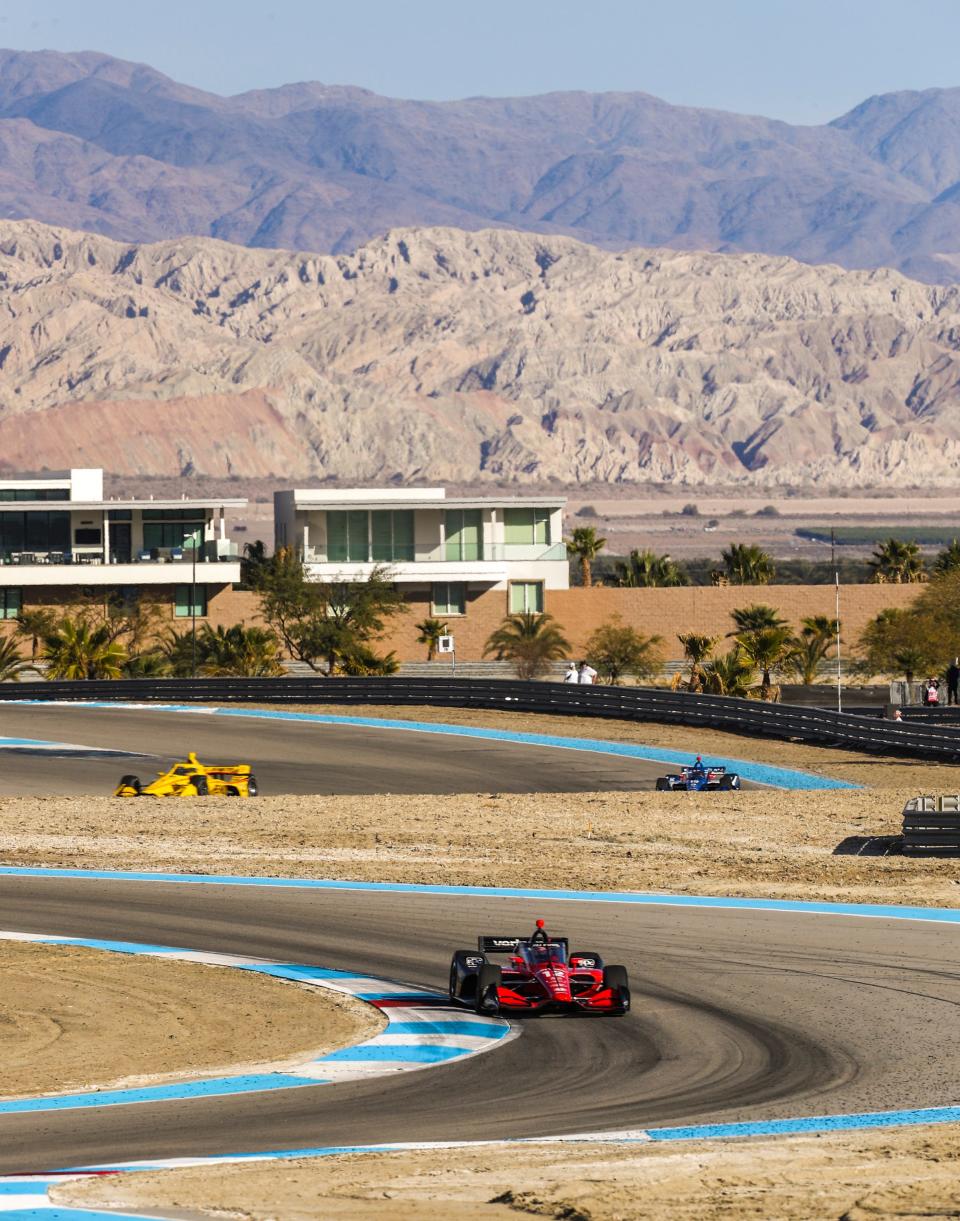How does IndyCar's $1 Million Challenge work? Here are answers to your questions.
Six months after the $1 Million Challenge was formally announced and with days until it begins, IndyCar has finally unveiled the for the series’ first non-points race in more than 15 years.
The weekend at The Thermal Club, the private, gated community that houses a series of racetracks 40 minutes east of Palm Springs, Calif., culminates with a 20-lap main event that includes a halftime break – but no pitstops and pays $500,000 to the winning team.
If you find yourself a bit confused by the name – no $1 million prize for the $1 Million Challenge? – or the format, you’re not alone. Here are some answers to your questions.

Why is it called the $1 Million Challenge if the grand prize is $500,000?
Like several tentpole projects in IndyCar of late – the hybrid launch, Nashville finale and video game to name a few – plans for the $1 Million Challenge have changed a bit since it was formally announced the morning of the Sept. 10 season-finale. At the time, plans were that members of The Thermal Club would help fund the event’s purse by pitching into a multi-million-dollar pot – and with their donation, be entered into a raffle to be randomly paired with one of the drivers in the 27-car field.
If their driver finished in the top-5, they would split the winnings with the teams – with prizes ranging from $1 million (so $500,000 each for 1st place) to $100,000 ($50,000 each for 5th place).
Revealed last week, that purse-sharing mechanism has now been scrapped, though the previously announced amounts for teams will go unchanged.
Inside The Thermal Club: What a $5.2 million membership gets you
What are the actual payouts for teams?
The $1.756 million purse, the series’ largest outside the Indianapolis 500, is broken down as such:
∎ Winner: $500,000
∎ Runner-up: $350,000
∎ Third place: $250,000
∎ Fourth place: $100,000
∎ Fifth place: $50,000
∎ Sixth-27th places: $23,000 each

Is there still a member element to the weekend?
Yes. Before cars hit the track Friday morning for a two-day test with nine available hours of run-time on the 3.067-mile, 17-turn permanent road course, the club will host a draw party Thursday night that will serve two purposes: 1) Drivers will be randomly separated into two groups that they will qualify with Saturday evening and compete in a heat race with Sunday morning (more on all that in a minute).
But 2) Thursday’s draw party will also pair drivers and teams with Club members who will then be embedded for the weekend and given access to “team meetings, driver question-and-answer sessions, race craft instruction and tips, and use of premium, authentic race team gear,” according to the release.
'I would love to race here': Takeaways from IndyCar's open test at The Thermal Club
So there are qualifying and heat races?
Yes. Similar to IndyCar’s typical road and street course qualifying, the field will be split in half for a pair of 12-minute sessions run Saturday evening during a 45-minute session that will air on NBC’s Peacock streaming platform (5-5:45 p.m. local/ 8-8:45 p.m. ET). But unlike traditional weekends, where the field is split in half by alternating off the lap times from Practice 2, this will be entirely random – meaning you could have an uneven weight of IndyCar’s top drivers in one group.
As is the case in current road and street course qualifying, the 12-minute clock will stop for the first instance of a red flag in each group, and the clock will restart according to direction from race control. Time will not stop for any subsequent red flags. For the first time in IndyCar qualifying, each car will be enabled with 40 seconds of push-to-pass boost.
After those 12-minute qualifying sessions Saturday evening, both groups will be ranked separately by drivers’ fastest lap times, serving as their starting positions for Sunday’s pair of heat races.
How do the heat races work?
Sunday’s on-track action starts with a 9:31 a.m. PT/12:31 p.m. ET green flag for the first of two heat races – essentially kicking off the two-and-a-half-hour NBC broadcast. The top-six finishers from each heat race will advance to the 20-lap ‘all-star race.’ It the first use of heat races for an IndyCar-sanctioned event in more than a decade.
The heat races will consist of 10 laps of green-flag running – or 20 minutes from the start of the first green flag, whichever comes first. Laps run under caution – i.e. laps that had any portion run under full-course caution – will not count to the 10-lap count, but the clock will continue to run. Laps will be deemed complete when the leader crosses the start-finish line. Should a full-course caution be thrown, cars’ positions on-track will be determined by the last timeline crossed at the moment of the yellow flag.
Teams will be given a new set of Firestone tires for their car’s lone heat race, and the tires used during the previous day’s qualifying session will be the only ones permitted as a replacement set if needed. Pit stops will only be allowed for emergency service, and a car deemed to have made a non-emergency adjustment during a stop will be disqualified. Just as in qualifying on Saturday, cars will get 40 seconds of push-to-pass for their heat race.
Ticket prices slashed: After shock of $2,000 tickets for $1M challenge, cost lowered to $500

How does the $1 Million Challenge main event work?
The top-six drivers from both heat races are pooled into a single 12-car ‘all-star’ field, positioned in alternating fashion. The pole for the main event will be awarded to whichever heat race winner logged the fastest qualifying time. The field will alternate from there – for example, with Heat 1 drivers occupying sports 1, 3, 5, 7, 9 and 11 (or vice versa).
The 20-lap final will be split into a pair of 10-lap sprint segments with a 10-minute halftime break after Lap 10, during which cars can refuel, adjust front and rear wing angles and wickers, adjust tire pressure and attend to the driver. Drivers will get 40 seconds of push-to-pass to use during each 10-lap segment, and that pool will reset after the break.
During the main event, laps run under full-course caution will also not count toward the 20-lap pool, but there will be no time limit for the event – unlike the heats. During the second 10-lap sprint segment, cars’ positioning during a full-course caution will be determined by their actual running order on-track, rather than by the previous timing line they crossed.
Before the start of the final, cars will get a new set of tires, and the tires they used during their heat race will be on-hand as their replacement set if needed. Cars will only be permitted to make stops outside the halftime break for emergency service.
This article originally appeared on Indianapolis Star: How IndyCar's $1 Million Challenge at The Thermal Club will work

